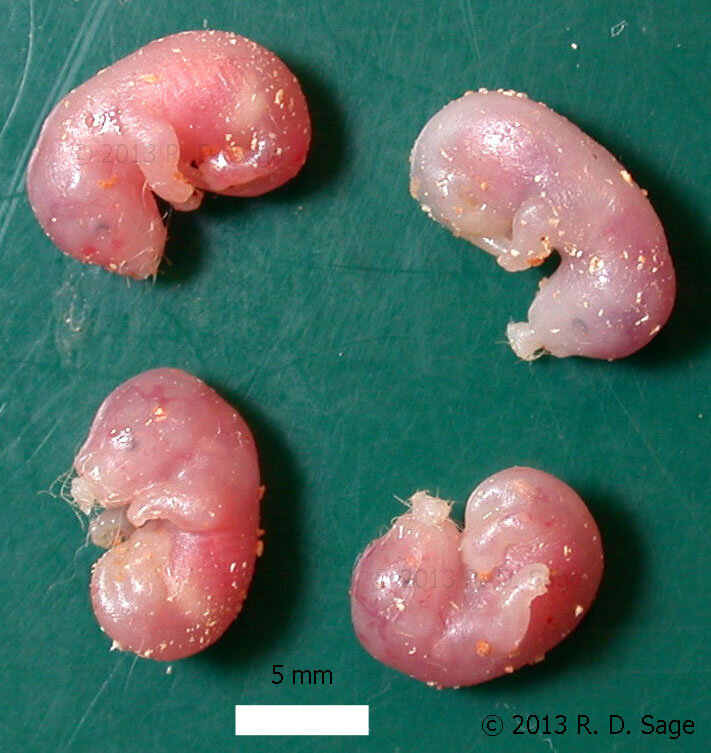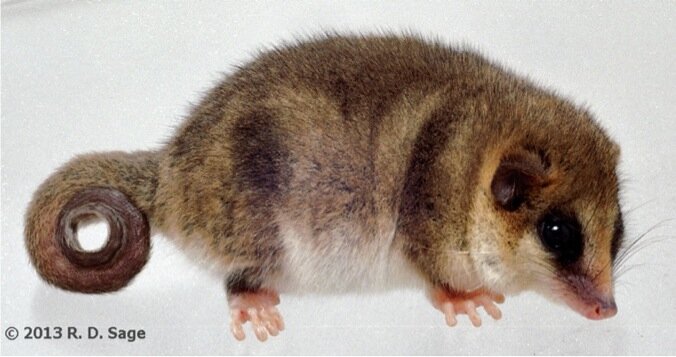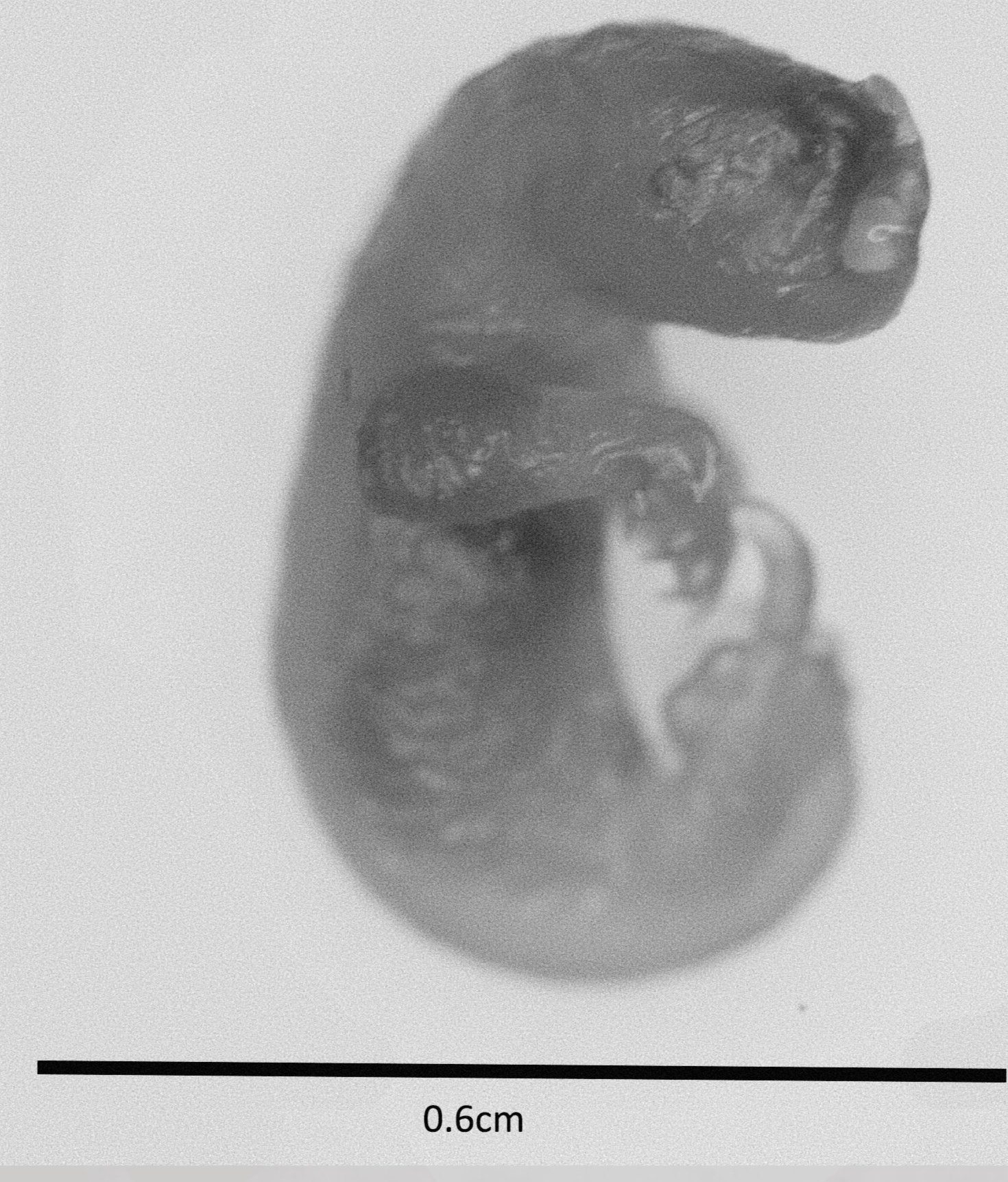Monito del monte Dromiciops gliroides development



Dromiciops gliroides newborn pouch young RDS18110

Monito del monte (Dromiciops glidoires) female with 4 pouch young in the pouch (only one is observed out of the pouch).
Introduction
The monito del monte (Dromiciops glidoires) is a small scansorial mostly arboreal microbiotherian possum originally found in Southern Patagonia (Southern Argentina and Chile). It belongs to the Order Microbiotheria (Ameghino 1889).
Dromiciops lives in the temperate Valdivian Nothofagus-Chusquea forests of southern Chile and adjacent areas in western Argentina. Dromiciops has also been found to inhabit non-native introduced Eucalyptus plantation forests in Chile (Fontúrbel et al. 2014). Phylogenetically, D. gliroides is considered to be more closely related to Australasian rather than American marsupials and is placed in the Australidelphia (a clade that includes all Australasian marsupial orders and Microbiotheria; Szalay 1982, 1994).
The species has not been bred in captivity in Argentina but has been caught and kept in cavity in Argentina and Chile (pers. observ.).
As an adult, Dromiciops weighs between 14 and 45 grams.
Reproduction:
Reproduction of Monito del monte occurs in mid to late Spring between Early October and November. Dromiciops seems to be a monoestrus, seasonal breeder producing one litter per year (Muñoz- Pedreros et al. 2005).
Copulation occurs for a short period of time but this is not known exactly for how long (hours).
Embryogenesis occurs in October in Chile (intrauterine embryos were observed on the 15th and 16th October in Chile by Muñoz-Pedreros et al. 2005) and can also occur in November to Early December. The exact length of intra-uterine development remains unclear, but this period might last for 3-4 weeks until the end of October and until early November.
The young are born between Mid November to early to mid December and the total time of gestation is not known. The average litter size is 4 and females only have four teats in their pouch. It is not known if females mate again or wait to mate the following spring
Ontogeny of intra-uterine young
At birth Dromiciops are observed to have already developed olfaction and thus may have a well developed olfactory placod. They are able to move towards the teat and have forelimb movement and dactyl flexion. Which are all features required for the migration towards the marsupial opening. Muñoz-Pedredos et al. (2005) observed that these characteristics observed in Dromiciops altricial young were noted in stages of advanced ontogeny compared to other embryonic organ and neuro-muscular systems.
Birth: At birth the neonate has a well-developed head and fore limbs while the posterior end of the body is strongly flexed ventrally. The hind limbs are not fully developed. The crown-rump length of a neonate at birth is approximately between 9-11 mm and weight is between 0.04-0.13g (Schneider and Gurovich, 2017). There is a very distinct developed oral region observed as the oral shield (to allow the young to remain attached to the teat for the first month of life in the pouch) (Scheneider and Gurovich, 2017).
15-20 days after birth postpartum: Microphotographs of Dromiciops were used to observe external anatomy by Frankham and Temple-smith (2012). Eye discs (but not developed eyes) and ears were clearly distinguished in all pouch young; eyelids were not yet separated and the ears were still flattened against the head. At 15-20 days after birth the pouch young had no fur, and there no vibrissae or whiskers yet developed on the snout.
Sex can be determined at an 15-20 days (Frankham and Temple-Smith, 2012) as they observed pouches in females and the absence of a pouch and presence of scrotal bulge in males (which is always cranial to the phallus in marsupials).
Male Dromiciops at 15-20 clearly do not have mammary anlagen and this is similar to Australasian marsupials. However some male American marsupials do have mammary anlagen and this was observed in Didelphis and Monodelphis by different authors (Bresslau, 1912; Renfree et al. 1990).
2 months: Dromiciops are still suckling at 2 months and attached constantly to the teat and measure approximately 33-36mm crl (Jiménez & Rageot, 1979).
3 months old: While keeping a mother and 4 young in captivity captured in February 1978 in Southern Chile, Jiménez & Rageot, (1979) observed that at 67 days the young were no longer attached to the teat and had left the pouch. The eyes of Dromiciops open at about 77 days (Jiménez & Rageot, 1979). At 78 days approximately after birth (Jiménez & Rageot, 1979) observed the young having more substantial fur covering and eating fruit (for the first time after solely surviving by suckling mothers milk).
4 months: At approximately 4 months of age Dromiciops pouch young have Increased motor capacities and leave the marsupium for short exploratory excursions . This exploratory period (late December-January) is marked by excursions, which increase both in frequency and duration as young acquire autonomy. Juvenile Dromiciops continue to suckle during this period and thus occupy the nest as a center for home-range activities Pouch young are suckled for
6 months: By the end of 5 months (March) juveniles are independent but it is thought suckling continues until April (Muñoz-Pedreros et al. 2005). Dromiciops are not fully weaned till approximately 6 months of age (Muñoz-Pedreros et al. 2005) as observed to occur around April in Chile. Female adult lactating Dromiciops were found to have well-developed marsupium (pouches) in April, with functional teats (Lang, pers. observ.).
Sexual maturity is probably achieved after the following year and monito del montes may not be sexually mature until they turn 2 (Muñoz-Pedreros et al. 2005).
Dromiciops pouch
The pouch is a typical marsupial structure used to protect the young during its development while attached to the teat.
Marsupials have either well-developed deep pouches that open anteriorly or posteriorly, they may possess pouches that only develop in the breeding season or some species may not possess a pouch at all (Tyndal-Biscoe and Renfree 1987; Tyndal-Biscoe, 1985).
Pouch development is often used in phylogenetic analysis (e.g. Edwards and Deakin 2013; Schneider and Gurovich, 2017).
Dromiciops gliroides (Monito del monte) are the only extant species in the ancient order Microbiotheria, and the sole New World representative of the superorder Australidelphia 8-10, making them very interesting for phylogenetic studies.
Externally the pouch is observed in female D. gliroides pouch young that are aged between 15-30 days old as an U-shaped depression surrounded by thick lips, anterior to the genital tubercle. This corresponds to other species of Marsupials e.g Macropus eugenii, the pouch can be identified externally but with difficultly in females 5 days..
In Dromiciops adult females the pouch is observed to change in morphology during the breeding season (Fig. 2-5). This morphology is important when using morphological descriptions for phylogenetic analysis (Fig.1). Dromiciops’ pouch is observed by various authors as “consisting of separate lateral skin folds opening medially”.
As in other marsupials, secretions of pouch glands seem to increase towards birth and continues during suckling, here visible as yellow to reddish colour of the hair surrounding the pouch (Fig. 3, 5 see below). This secretion is important for its antimicrobial activity, protecting the young against pathogenic infections.
While the outer lip of the pouch is more distinct in pregnant and suckling females, it never consists (not even during development) of two separate lateral skin folds that open medially as previously described6, but is U-shaped and opens anteriorly.
Dromiciops pouch morphology of a lactating female the pouch is very obvious and teats are very enlarged.
References
Ameghino F (1889) Contribucion al conocimiento de los mamiferos fosiles de la República Argentina: Obra escrita bajo los auspicios de la Academia nacional de ciencias de la República Argentina para ser presentada á la Exposicion universal de Paris de 1889 (Vol. 6). PE Coni é hijos.
Bresslau, E. 1912. Die Entwicklung des Mammarapparates der Monotremen, Marsupialier und einiger Placentalier. Pp. 653–874 in Zoologische Forschungsreisen in Australien (R. Semon, ed.). Gustav Fischer, Jena, Deutschland.
Edwards and Deakin 2013 Aust J Zool 61, 41-47
Fontúrbel FE, Candia AB, Botto-Mahan C (2014) Nocturnal activity patterns of the monito del monte (Dromiciops)
Frankham GJ, Temple-Smith PD (2012) Absence of mammary development in male Dromiciops gliroides: another link to the Australian marsupial fauna. J Mammal 93, 572–578.
Gurovich et al. 2013 Aust Mammal Conf., p68; 12
Hermick et al 2013 Euglena 1, 17-25
Jiménez J, Rageot R (1979) Notas sobre la biología del Bmonito del monte^, Dromiciops australis Philippi 1893. An Mus Hist Nat Valpso 12:83–88
Muñoz-Pedreros A, Lang BK, Bretos M, et al. (2005) Reproduction and development of Dromiciops gliroides (Marsupialia: Microbiotheriidae) in temperate rainforests of southern Chile. Gayana 69, 225–233.
Peel et al 2013 Microbial pathogens and strategies for combating them: Science, Technology and Education 2, 1247-1256
Renfree, M. B., E. S. Robinson R. V. Short, and J. L. Vandeberg. 1990. Mammary glands in male marsupials 1. Primordia in neonatal opossums Didelphis virginiana and Monodephis domestica. Development 110:385–390.
Renfree et al 1996 Anat Embrol 194, 111-134
Schneider NY, Gurovich Y (2017) Morphology and evolution of the oral shield in marsupial neonates including the newbornmonito del monte (Dromiciops gliroides, Marsupialia Microbiotheria) pouch young. J Anat 231:59–83
Szalay FS (1982) A new appraisal of marsupial phylogeny and classification. In: Archer M(ed) Carnivorous Marsupials. Royal Zoological Society of New South Wales, Sydney, pp 621–640
Szalay FS (1994) Evolutionary History of theMarsupials and an Analysis of Osteological Characters. Cambridge University Press, New York.
Tyndal-Biscoe and Renfree 1987 Reproductive physiology of marsupials.
Tyndale-Biscoe 2005 Life of marsupials
Voss and Jansa 2003 276, 1-82
Voss and Jansa 2009 Bull Am Mus Nat Hist 322, 1-177

